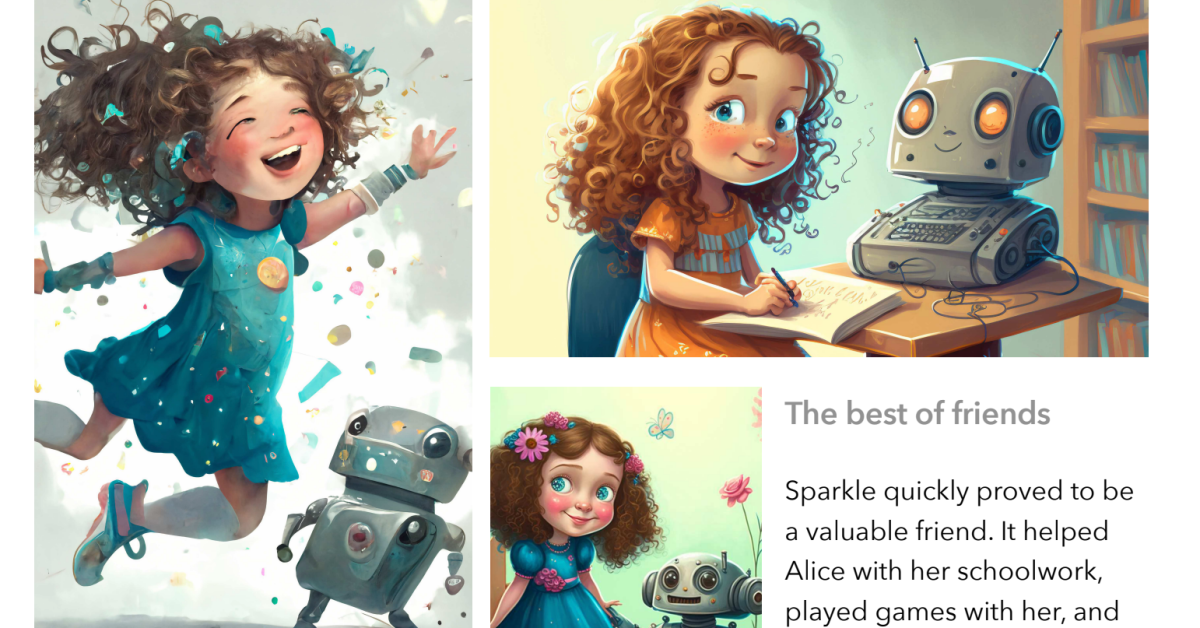Ammaar Reshi was playing around with ChatGPT, an AI-powered chatbot from OpenAI when he started thinking about the ways artificial intelligence could be used to make a simple children’s book to give to his friends. Just a couple of days later, he published a 12-page picture book, printed it, and started selling it on Amazon without ever picking up a pen and paper.
The feat, which Reshi publicized in a viral Twitter thread, is a testament to the incredible advances in AI-powered tools like ChatGPT—which took the internet by storm two weeks ago with its uncanny ability to mimic human thought and writing. But the book, Alice and Sparkle, also renewed a fierce debate about the ethics of AI-generated art. Many argued that the technology preys on artists and other creatives—using their hard work as source material, while raising the specter of replacing them.
Reshi, a product design manager from the San Francisco Bay Area, gathered illustrations from Midjourney, a text-to-image AI tool that launched this summer, and took story elements from a conversation he had with the AI-powered ChatGPT about a young girl named Alice. “Anyone can use these tools,” Reshi tells TIME. “It’s easily and readily accessible, and it’s not hard to use either.”
His experiment creating an AI-generated book in just one weekend shows that artificial intelligence might be able to accomplish tasks faster and more efficiently than any human person can—sort of. The book was far from perfect. The AI-generated illustrations had a number of issues: some fingers looked like claws, objects were floating, and the shadowing was off in some areas. Normally, illustrations in children’s books go through several rounds of revisions—but that’s not always possible with AI-generated artwork on Midjourney, where users type a series of words and the bot spits back an image seconds later.
Artists singled out this page from Alice and Sparkle as showing the limits of the AI-powered technology. The illustration has several apparent flaws, including the character appearing to have claws.
Courtesy Ammaar Reshi
Alice and Sparkle follows a young girl who builds her own artificial intelligence robot that becomes self aware and capable of making its own decisions. Reshi has sold about 70 copies through Amazon since Dec. 4, earning royalties of less than $200. He plans to donate additional copies to his local library.
Reshi’s quixotic project drew praise from many users for its ingenuity. But many artists also strongly criticized both his process and the product. To his critics, the speed and ease with which Reshi created Alice and Sparkle exemplifies the ethical concerns of AI-generated art. Artificial intelligence systems like Midjourney are trained using datasets of millions of images that exist across the Internet, then teaching algorithms to recognize patterns in those images and generate new ones. That means any artist who uploads their work online could be feeding the algorithm without their consent. Many claim this amounts to a high-tech form of plagiarism that could seriously harm human artists in the near future.
Reshi’s original tweet promoting his book received more than 6 million impressions and 1,300 replies, many of which came from book illustrators claiming artists should be paid or credited if their work is used by AI.
“In order to protect the rights and property of artists, there must be stricter regulation around how art is used to train AI algorithms,” says Michelle Jing Chan, an illustrator of children’s books. “Artists should be appropriately compensated when their works are used in the training of algorithms.”
“The main problem to me about AI is that it was trained off of artists’ work,” adds Adriane Tsai, also a children’s book illustrator. “It’s our creations, our distinct styles that we created, that we did not consent to being used.”
Already, some companies and brands are choosing AI technology over human talent. The San Francisco Ballet used images generated by Midjourney to promote this season’s production of the Nutcracker. A digitally-generated fashion model, Shudu Gram, has modeled for brands including Louis Vuitton. And at comedy clubs, artificial intelligence is being used to deliver standup jokes.
The phenomena has made many creatives nervous about their own futures, wondering if people will pay for their services when they could generate it for much cheaper using AI.
“As somebody who makes my money and finds my joy and writing, it’s deeply troubling to see people seeking cheap alternatives to actual human writing, which is already one of the most deliriously underpaid professions,” says Abraham Josephine Riesman, an author.
Reshi responded to these concerns by calling on the creators of the AI tools at OpenAI and Midjourney to ensure protections for artists and authors whose work may be used in artificial intelligence algorithms.
“I think there’s real concern and I actually do hear out those artists,” Reshi says. “It’s really important that the tech industry that’s working on these tools involves them in the process of creation.”
More Must-Reads From TIME



